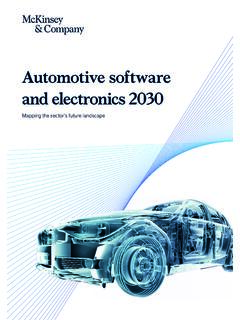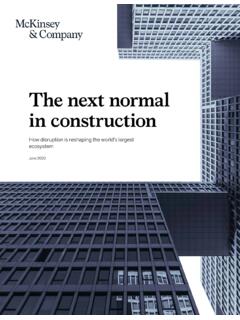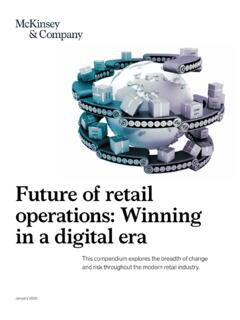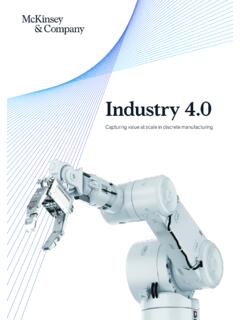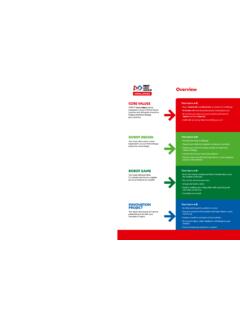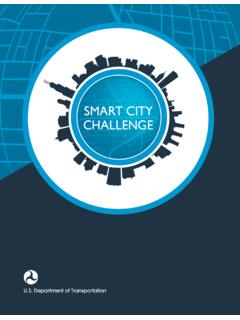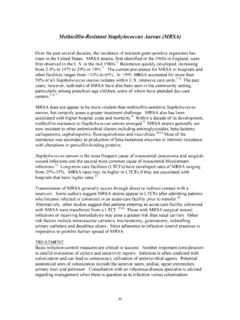Transcription of Decarbonization challenge for steel - McKinsey & Company
1 Decarbonization challenge for steel Hydrogen as a solution in EuropeThe steel industry Decarbonization challengeSteel is one of the core pillars of today s society and, as one of the most important engineering and construction materials, it is present in many aspects of our lives. However, the industry now needs to cope with pressure to reduce its carbon footprint from both environmental and economic perspectives. Currently the steel industry is among the three biggest producers of carbon dioxide, with emissions being produced by a limited number of locations; steel plants are therefore a good candidate for Decarbonization . While the industry must adapt to these new circumstances, it can also use them as a chance to safeguard its license to continue operating in the long 2015, the global response to the threat of climate change took a step forward when 190 nations adopted the Paris Agreement. In 2019, the United Nations announced that over 60 countries including the United Kingdom and the European Union (with the exception of Poland) had committed to carbon neutrality by 2050, although the three principal emitters China, India, and the United States were not among that Moreover, some nations have pledged to work toward earlier dates.
2 Together, these agreements have led to growing pressure to pursue Decarbonization across all industrial ton of steel produced in 2018 emitted on average tons of carbon dioxide, equating to about 8 percent of global carbon dioxide Consequently, steel players across the globe, and especially in Europe, are increasingly facing a Decarbonization challenge . This challenge is driven by three key developments that go beyond the Paris Agreement:1. Changing customer requirements and growing demand for carbon-friendly steel products. A trend that has already been observed in various industries, including the auto industry where manufacturers such as Volkswagen or Toyota have the ambitious aim of eliminating carbon emissions completely from their entire value chains (including their suppliers) and taking on a full life cycle perspective. 2. Further tightening of carbon emission regulations. This is manifested in carbon dioxide reduction targets, as well as rising carbon dioxide emission prices as outlined in the European Green Growing investor and public interest in sustainability.
3 For example, the Institutional Investors Group on Climate Change, a global network with 250-plus investors and over USD 30 trillion in assets under management, has raised expectations for the steel industry to safeguard its future in the face of climate change. At the same time, global investment firm BlackRock has confirmed its commitment to environmentally responsible business development and sustainable Climate Action Summit 2019, Report of the Secretary-General on the 2019 Climate Action Summit and the Way Forward in 2020, World steel studies estimate that the global steel industry may find approximately 14 percent of steel companies potential value is at risk if they are unable to decrease their environmental Consequently, Decarbonization should be a top priority for remaining economically competitive and retaining the industry s license to operate. Moreover, long investment cycles of 10 to 15 years, multibillion financing needs, and limited supplier capacities make this issue even more relevant and lock in significant lead times for addressing the Decarbonization challenge .
4 In response, Decarbonization measures such as establishing or switching to hydrogen-based (H2) steel production can be implemented either in forthcoming (greenfield) sites or existing (brownfield) The latter opportunity requires existing equipment to either be retrofitted or for the facility to possibly be completely rebuilt in order to implement a decarbonized production process. The optimal steps to Decarbonization will differ by location and site, depending on the likes of technical feasibility, existing infrastructure, market demands, operating costs ( , the price of renewable electricity, the price of scrap), and the regulatory of steel companies potential value is at risk if they are unable to decrease their environmental impact 3 Study of 20 global steelmakers. The weighted average value at risk for the sample is 14 percent of net present value under a 2 C scenario, where global carbon prices rise to USD 100 per ton of carbon dioxide. Results range from 2 percent to 30 percent for individual companies.
5 4 For example: retrofitting existing EAF plants for hydrogen-based steel production. 3 Going forward, steel producers need to assess, evaluate, and decide on a technologically and economically viable way to decrease their carbon can be produced via two main processes: either using an integrated blast furnace (BF)/basic oxygen furnace (BOF) or an electric arc furnace (EAF). While integrated players produce steel from iron ore and need coal as a reductant, EAF producers use steel scrap or direct reduced iron (DRI) as their main raw material. As the predominant production method in Europe is the conventional, coal-dependent BF/BOF process, the need to assess alternative breakthrough technologies to reduce carbon dioxide emissions is high. Indeed, almost all European steel producers are currently developing Decarbonization strategies and running pilot plants to assess different production technologies (Exhibit 1). These include: BF/BOF efficiency programs. Such programs improve efficiency and/or decrease production losses in different ways, for example: 1) optimizing the BF burden mix by maximizing the iron content in raw materials to decrease the usage of coal as a reductant, 2) increasing the use of fuel injection through, for example, pulverized coal injection (PCI), natural gas, plastics, biomass, or hydrogen (as an additional reagent on top), or 3) using coke oven gas in the BF as an energy source, just to name some of the options.
6 These processes may have the potential to decrease carbon dioxide emissions without eliminating them, but do not offer fully carbon-neutral steel production. Biomass reductants. This process uses biomass, such as heated and dried sugar, energy cane, or pyrolyzed eucalyptus, as an alternative reductant or fuel. As such it is regionally dependent and mainly important in areas where the biomass supply is guaranteed, like in South America or Russia. In Europe, the availability of biomass is likely not enough to reduce carbon emissions on a large scale. Carbon capture and This uses emissions to create new products for the chemical industry, such as ammoniac or bioethanol. At present, carbon capture and usage remains technologically premature and yet to be proven share of scrap-based EAFs. This process maximizes secondary flows and recycling by melting more scrap in EAFs. EAF producers are more environmentally friendly and flexible to the ups and downs of demand.
7 However, shifting to EAF-based steel production requires the future supply of renewable electricity to be commercially available, as well as a sufficient supply of high-quality steel scrap. High quality scrap is necessary for the production of high-quality products, which are nowadays mainly produced through the integrated route. If high-quality scrap is not available, lower-quality scrap can be mixed with DRI to ensure a high quality EAF Increasing the share of EAF-based steel production will play a key role in decarbonizing the steel industry. However, this role will be dependent on the regional availability of high-quality scrap and could therefore be limited in regions with an inadequate supply of high-quality scrap, making other technologies a must. Increasing demand for high-quality scrap will also lead to extra cost for the EAF-based steel production. Technology landscape for Decarbonization in steel production5 Carbon capture and storage not further detailed as political/regulatory approval is uncertain across different regions due to potential insecurities during The exact scrap/DRI ratio depends on the scrap quality and end product.
8 4 Optimize DRI and EAF. This requires boosting usage of DRI in combination with EAF. DRI-based reduction emits less carbon dioxide than the integrated method and enables the production of high-quality products in the EAF. High-quality products require the highest quality of steel scrap; if scrap is limited, the use of DRI is necessary to guarantee specific qualities. DRI production requires cheap and readily available natural gas. Thus, regions with low natural gas prices the Middle East or North America are big DRI producers whereas the process is less common in Europe. Selected European steel players import Hot Briquetted Iron (HBI, a less reactive and therefore transportable form of DRI) to use either in the BF to optimize the burden mix or in the EAF where they mix it with scrap in order to increase and EAF using hydrogen. This uses green hydrogen-based DRI and scrap in combination with EAFs. The process replaces fossil fuels in the DRI production stage with hydrogen produced with renewable energy.
9 It represents a technically proven production method that enables nearly emission-free steel production. All major European steel players are currently building or already testing hydrogen-based steel production processes, either using hydrogen as a PCI replacement or using hydrogen-based direct reduction. At this point it is important to note that EAF-based steel production will not require a completely green hydrogen-based DRI supply to be able to fulfill current customer requirements and achieve carbon neutrality. As BF/BOF efficiency programs only result in a reduction in carbon dioxide emissions, without eliminating them entirely, they cannot be a long-term solution. Biomass reductants and carbon capture and usage are either only feasible in certain regions or still in the early stages of development. The share of EAFs producing high-quality steel will increase but requires the availability of scrap and DRI. Hence, adopting an approach combining scrap, DRI, and EAF using hydrogen is currently considered the most viable option and the long-term solution to achieving carbon-neutral steel production, especially in 1.
10 steel producers are evaluating Decarbonization strategiesReplace fossil fuels in DRI process with renewable energy or H2 MIDREX DRI process running on H2 HYL DRI process running on H2 DRI plus EAF using H2 Focus of this documentMake efficiency improvements to optimize BF/BOF operations Optimized BOF inputs (DRI, scrap), increased fuel injection in BF ( , hydrogen, PCI)Blast furnace efficiency (BOF) Technology readily available at competitive costTechnology available at high costMaximize secondary flows and recycling by melting more scrap in EAFI ncrease usage of DRI in the EAF EAF usage to melt scrapElectric arc furnace (EAF)DRI plus EAF using natural gasCurrent DRI plus EAF plants using natural gas (NG)Technology readily available at competitive costTechnology readily availableUse biomass as an alternative reductant or fuelTecnoredprocess Biomass reductantsProcess possible in South America and Russia, due to biomass availabilityCapture fossil fuels and emissions and create new productsCarbon capture and usageBioethanol production from CO2emissionsNot available on an industrial scaleCO2reduction Full Decarbonization possible ExamplesCurrent outlookStrategySOURCE: McKinsey analysis5 Although hydrogen is one of the most abundant elements on earth, in its pure form it is rare.





